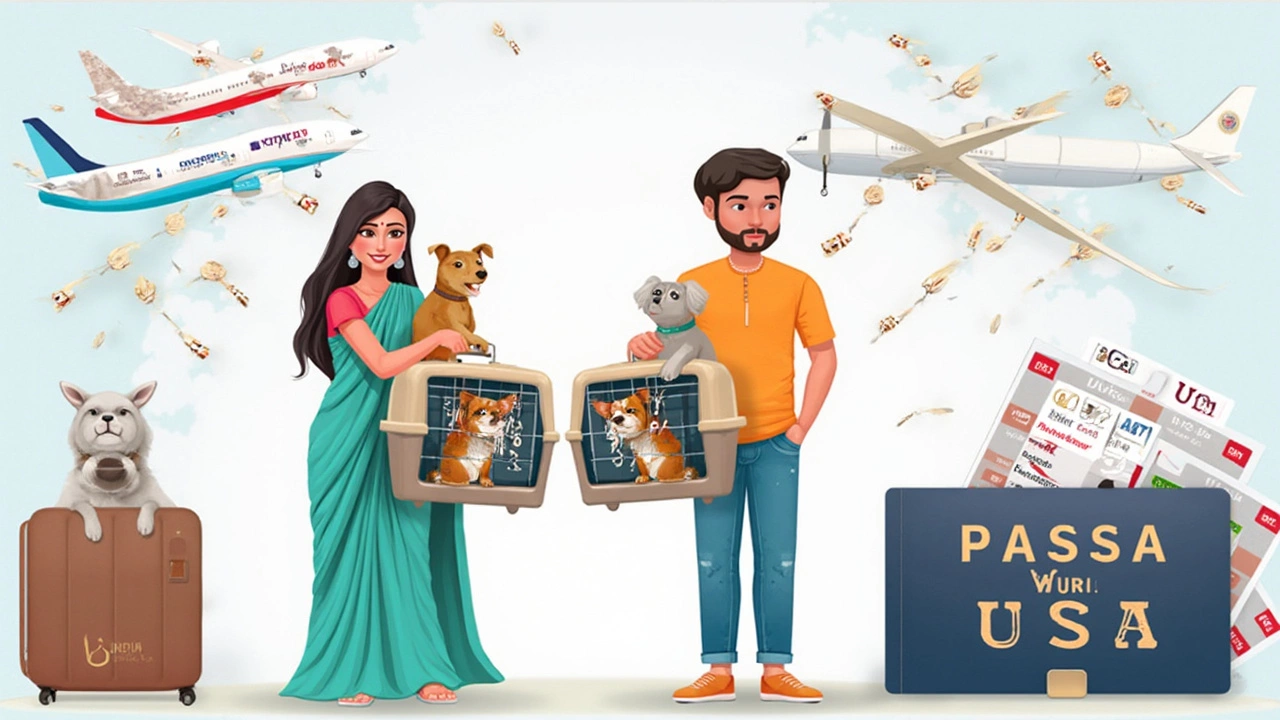
If you’ve ever tried flying with a pet, you know those extra charges can sneak up fast. Each airline sets its own pet fee, and the difference can mean an extra meal out or a painful dent in your trip budget. Nobody advertises their pet policy like they do Wi-Fi or extra legroom. So how do you sniff out the cheapest way to bring your cat or dog on board?
The truth: some airlines are a lot friendlier to your wallet than others. Alaska Airlines, for example, typically leads the pack with the lowest pet-in-cabin fee—just $100 each way as of spring 2025. That’s $25-50 less than what you’ll pay on Delta, American, or United. Meanwhile, Southwest charges $125 each way, and JetBlue sits right at $125 too. Worse, some budget lines like Spirit and Frontier don’t offer checked pet options at all, and their in-cabin rates aren’t always much better.
But there’s more to the story than the sticker price. Most airlines put a limit on how many pets can fly per flight, so popular routes can sell out all their pet spots. Booking early makes a real difference. Also, fees can change based on flight length, pet size, or even if you call customer service versus booking online. Always double-check the airline’s current page before you hit that final ‘Book Now’ button.
- How Airlines Set Pet Fees
- Comparing Major Airline Pet Fees
- Hidden Costs and Gotchas
- Smart Ways to Save on Pet Travel
- Other Factors Besides Fee Amount
How Airlines Set Pet Fees
Ever wonder why pet fees can be so random from airline to airline? It all boils down to how they calculate risks, demand, and what it takes to juggle pets and people in a tight, busy space. There’s no government rule forcing airlines to charge a standard fee. They just set what they think the market will pay—and what covers their hassle.
Most airlines set their pet travel fee as a flat rate, meaning you pay the same amount no matter how short or long your flight is. In-cabin pet travel is different from checked pet travel (when pets go in the cargo hold)—and yes, the fees can be miles apart. Bigger pets that must go in cargo usually get slapped with higher fees. But carriers like Southwest and JetBlue only allow small pets (under 20 lbs) inside the cabin, as cargo can be riskier and demands extra handling.
Here’s what usually goes into the fee:
- Space on the flight: Airlines only allow a certain number of pets per cabin trip, sometimes as few as four. Less supply, more demand means higher costs.
- Paperwork and rules: Airlines handle medical records, special tags, and sometimes paperwork fees to meet different state or country laws.
- Extra cleaning: Extra cleaning after each flight bumps up costs for airlines, and that trickles down to you.
- Employee time: Pets mean more attention and training for staff—it’s not just about loading luggage anymore.
Here’s a quick look at common pet-in-cabin fees on top U.S. airlines (as of May 2025):
| Airline | Pet-in-Cabin Fee (One Way) | Max Pets Per Cabin |
|---|---|---|
| Alaska Airlines | $100 | 5 |
| American Airlines | $125 | 7 |
| Delta | $125 | 4 |
| United | $125 | 4 |
| Southwest | $125 | 6 |
| JetBlue | $125 | 6 |
Remember, these fees don’t usually cover bigger issues like canceled flights, overnight pet stays, or trips to international destinations, which can rack up extra charges fast. Checking your airline’s website before you book is the smart way to avoid ugly surprises at check-in.
Comparing Major Airline Pet Fees
When you’re looking for the best deal to fly with your pet, the fees can make or break your plans. Policies change often, but as of May 2025, here’s how the most popular U.S. airlines stack up for in-cabin pet travel. We're talking about a one-way trip fee for a small dog or cat in a soft carrier that fits under your seat.
| Airline | Pet-In-Cabin Fee (One Way) | Checked Pet? | Special Notes |
|---|---|---|---|
| Alaska Airlines | $100 | Yes | Lowest major airline fee; both carry-on and checked pets allowed |
| Delta | $125 | No | No checked pets since 2020 for most routes |
| American Airlines | $125 | No | Checked pets only for active military & government |
| United | $125 | No | Checked pets via cargo partner, not as baggage |
| Southwest | $125 | No | Only small dogs & cats, domestic flights only |
| JetBlue | $125 | No | Includes free pet carrier tag, limit one pet per passenger |
| Spirit | $125 | No | Pets must be able to stand and turn around in carrier |
| Frontier | $99 | No | Low fee but fewer pet-friendly routes |
What jumps out? Frontier’s fee is the lowest at $99, but Alaska’s $100 charge is the cheapest among full-service carriers that allow both carry-on and checked pets. Almost every airline charges pet travel fees around $125, so anything south of that is a rare deal.
One useful real-world tip—a lot of travelers recommend Alaska for not just the low price, but because staff seem better trained for handling pets. A USA Today report even said,
"Alaska Airlines continues to be a favorite for pet owners thanks to its consistent policies, reasonable prices, and staff knowledge about animal care."
Remember, most airlines don’t allow pets as checked baggage anymore; if your animal can’t fit under your seat, you’re likely looking at pricier cargo options—sometimes $300 or more each way. Check each airline’s size and weight limit before booking, and don’t forget things change fast, especially after recent rule updates.
It pays to read the fine print and compare the overall experience, not just the dollar sign. Set your alerts, book early, and you’ll get a much smoother trip with your pet in tow.

Hidden Costs and Gotchas
Here’s where things can get tricky—even if you lock in a low pet fee, surprise expenses can crash your travel budget. Most folks look at that headline number and miss the extra charges hiding in the fine print.
First off, airlines never include the money you’ll shell out for an airline-approved pet carrier. Those run about $40 to $80, and if your bag doesn’t fit their measurements at the airport, get ready to fork over more cash or watch your pet get bumped. Airlines like Delta and United are strict about carrier sizes. Make sure to check their max dimensions online (and maybe even bust out the tape measure).
| Airline | Max Length (inches) | Max Width (inches) | Max Height (inches) |
|---|---|---|---|
| Alaska | 17 | 11 | 7.5 |
| Delta | 18 | 11 | 11 |
| American | 19 | 13 | 9 |
Also, non-refundable pet fees sting if your flight changes or gets canceled. Airlines rarely refund pet charges, even if you don’t end up flying. If you need to rebook, you might pay the fee all over again. Plus, not every airport or plane allows pets, so check your route before buying tickets. Smaller regional jets often say no to in-cabin pets, and international trips may tack on even more charges (if they allow pets at all).
Here’s the clincher: Many budget airlines let pets fly only on certain routes, and they may charge more for booking through an agent or by phone. Frontier, for example, adds up to $99 for changing your reservation, pet or not. That’s not even counting airports with extra screening fees for pet carriers.
If you’ve heard stories of people getting charged at the gate or even denied boarding, you’re not alone. As
USA Today’s travel reporter Dawn Gilbertson puts it: “Read the pet policy line-by-line—I’ve heard from travelers caught off guard by weight limits or obscure paperwork rules, especially last-minute.”
To duck these gotchas, keep your paperwork in order and double-check your routing. Some countries or states—like Hawaii—require paperwork you need to handle weeks before your trip, and missing even one form can mean your pet sits this vacation out.
- Always budget for a new carrier, just in case.
- Print two copies of all vaccine and vet records.
- Call the airline if you have any doubts about your plane, airport, or pet’s eligibility.
Busting open the fine print now can save big headaches and extra charges when you travel with your pet.
Smart Ways to Save on Pet Travel
No one wants to blow half their budget before even reaching the airport. Sure, you can’t dodge every fee, but with a little planning, those extra charges don’t have to sting as much. Here’s exactly how to pinch pennies when booking pet travel.
- Book Early: Airlines limit the number of pets allowed in the cabin per flight. Lock in a spot as soon as you know your dates, especially around holidays or school breaks. Wait too long, and your only option may be a higher-priced flight—or nobody lets Fido fly at all.
- Compare Fees And Options: Alaska Airlines usually wins for lowest fee, but always check the exact total during booking. Sometimes deals or seasonal discounts pop up that make another airline suddenly cheaper.
- Watch for Upgrades: Some travelers report saving cash by requesting a pet spot when snagging a last-minute seat upgrade. Ask at the counter—it never hurts to check if they’ll roll the pet fee into a better seat package.
- Use Points or Travel Rewards: Several airlines (like JetBlue) let you pay all or part of the pet fee with their own travel points. If you’re sitting on unused miles, putting them toward your pet’s ticket can take the sting out.
- Prep Paperwork Ahead: If you forget a required document (like a vet health certificate), airlines sometimes charge a reprocessing or late fee. Save stress and extra charges by having every document ready before you fly.
| Airline | Pet Fee (One Way) |
|---|---|
| Alaska | $100 |
| Delta | $125 |
| American | $125 |
| United | $125 |
| Southwest | $125 |
| JetBlue | $125 |
| Spirit | $125 |
One lesser-known tip: If you’re flying with more than one pet, Alaska allows two pets in the same carrier for the same $100 fee (if they fit and get along). That’s rare among U.S. airlines, so if you’re traveling with a pair, you’re getting double value. If you don’t see your preferred airline here, check their rules—fees can shift without warning, and not all airlines offer the same services, especially for bigger dogs.
If you travel for work or family a lot, look into airline loyalty programs, which can sometimes land you waivers or perks for frequent flyers. Even if you only save a few bucks here and there, your wallet—and your pet—will thank you every trip.

Other Factors Besides Fee Amount
Finding the lowest fee is awesome, but don’t stop there. Airlines have all sorts of rules that can make or break your trip with your pet. For starters, not all pets are allowed. Most airlines only let small dogs and cats in the main cabin, and your pet’s carrier usually has to fit under the seat in front of you. On average, your buddy and their crate have to come in under about 20 pounds, but the exact weight and size rules are different everywhere.
Even when an airline advertises a low fee, the pet limit per flight can be tiny—like only four pets on board—that means waiting till the last minute can leave you grounded. Another big detail: some airlines just don’t allow pets on long-haul or international flights at all, or they might ban them during extreme temperatures. For example, Delta, American, and United all have blackout dates for pets in cargo during summer months when it’s just too hot.
If you need your pet to fly as checked baggage or in cargo, brace yourself for way different experiences. Some airlines now refuse to carry pets as cargo after past safety incidents, while others require a mountain of paperwork, vet checks, or require booking through partner cargo services. One flight delay or missed connection could mean hours of stress.
Also, don’t ignore the quality of the airline’s pet policies. Alaska Airlines, for example, is pretty relaxed and has a consistently good record for pet travel safety. Airlines like JetBlue even offer a special program called JetPaws—little things like this can make a big difference, especially if it’s your first time navigating pet travel. Look for policies on things like layovers, non-stop flights, and whether you’re allowed to book your pet online or if you need to call customer service to confirm a spot.
Last thing—always check the rules for your destination. Some cities and states have extra rules or vaccination requirements for incoming pets, and international trips can get super complicated—a rabies shot or microchip might be non-negotiable. Skipping those steps can land your pet in quarantine (or stuck at home).
- Double-check carrier size and weight restrictions before you book.
- Book early, especially on airlines with a pet spot limit.
- Read up on the pet travel policies for your exact route and airline.
- Think about your pet’s comfort and safety, not just the price.
- Always research local rules at your destination.


